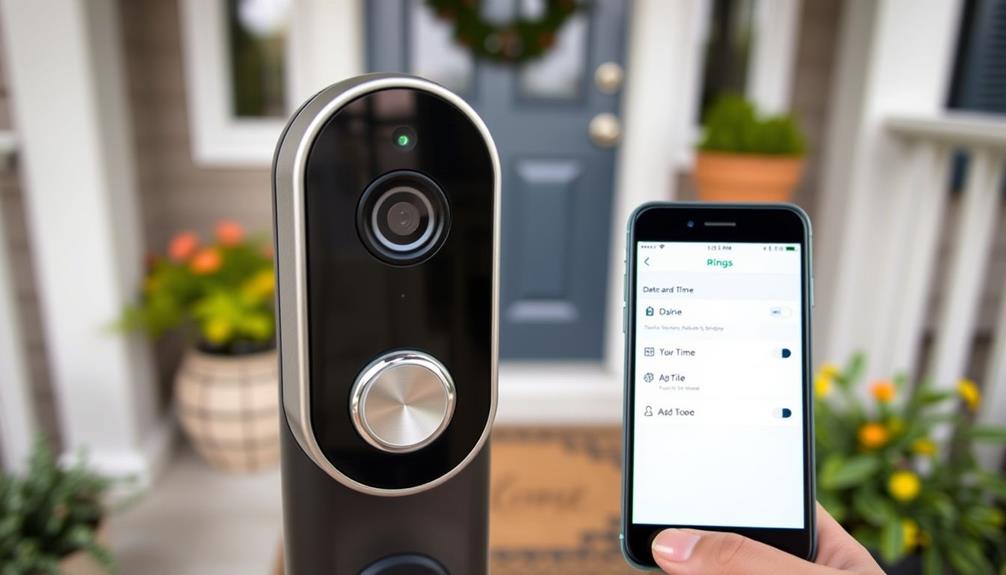To keep your Ring doorbell from freezing, you need to focus on placement and maintenance. Install it in a shaded area, away from heating sources and moisture-rich spots like gutters. Regularly clean the lens to prevent condensation and consider using desiccant packets to absorb excess moisture. Indoors, fully charge the battery at room temperature before remounting it outside. Applying anti-fog solutions can also help maintain visibility. For a reliable performance this winter, several strategies can enhance your doorbell's resilience against the cold. Discovering these tips can make a significant difference in keeping your device functional. One important factor to consider is how to prevent doorbell fogging. Ensuring proper ventilation and airflow around the doorbell can help minimize condensation buildup. Additionally, adjusting the sensitivity of the motion sensor can reduce the frequency of false alerts caused by foggy conditions. By implementing these strategies, you can effectively protect your Ring doorbell from freezing and maintain its performance throughout the winter months. One more way to prevent ring doorbell fogging is to regularly check and replace the weather-stripping around your doorbell, which can help seal out moisture and maintain a consistent temperature. Additionally, consider investing in a weatherproof cover for extra protection against the elements. By proactively addressing these potential issues, you can ensure that your Ring doorbell remains reliable and functional, even in the coldest of temperatures. Preventing ring doorbell fogging is essential for maintaining clear visibility and optimal performance, especially during the winter months.
Key Takeaways
- Position the Ring doorbell in shaded areas to minimize dew formation and reduce freezing risks.
- Charge the doorbell indoors at room temperature before remounting it outside in cold weather.
- Regularly check and maintain battery health, as cold temperatures can significantly impact performance.
- Use anti-fog coatings and silicone sleeves to prevent moisture buildup and insulate against extreme temperatures.
Causes of Doorbell Camera Freezing
Why does your doorbell camera freeze in cold weather?
When temperatures dip below 0°C (32°F), the air's humidity levels become vital. High moisture content can lead to condensation forming on your camera, which is similar to how heat pump efficiency can be affected by environmental factors.
As the temperature continues to drop, this condensation can quickly freeze, creating a layer of ice that obstructs the camera's view and hampers its functionality.
In addition to ice, prolonged exposure to cold weather can cause dew to solidify into frost. This frost not only blocks your camera's lens but also affects its ability to capture clear footage, compromising your home security.
You might notice that your doorbell camera struggles to operate effectively during these frigid conditions, which can be frustrating when you rely on it for surveillance.
Understanding these environmental factors is essential for finding solutions to prevent freezing. By being aware of how humidity and temperature interact, you can take steps to mitigate the impact of cold weather on your doorbell camera, ensuring it remains operational when you need it most.
Correct Placement Strategies

Choosing the right spot for your doorbell camera can greatly reduce the risk of it freezing during cold weather. To implement effective correct placement strategies, consider positioning your camera in shaded areas. This helps minimize the formation of dew, which can lead to freezing issues.
Additionally, using essential oils like lavender oil can promote relaxation and reduce stress while you monitor your home's entryway. The morning sunlight can be your ally—place the camera where it can bask in strong sunlight to evaporate any overnight condensation that may accumulate.
Avoid placing your doorbell camera near heating and cooling appliances. These devices often increase humidity levels, contributing to moisture accumulation that can freeze.
Additionally, steer clear of moisture-rich fixtures like drains and gutters, as they heighten the risk of water ingress and frost formation.
Internal Drying Techniques

Regularly inspecting your Ring doorbell for internal fogging can help you quickly address any moisture issues before they damage the electronics. If you notice condensation, act promptly. Use a soft cloth to wipe away any visible moisture, and if the fogging persists, consider bringing the camera indoors during severe weather to minimize moisture exposure.
To further combat internal fogging, you can also utilize desiccants. Here's a quick reference table to guide you:
| Method | Description |
|---|---|
| Soft Cloth | Wipe the lens and internal parts to remove moisture. |
| Indoor Storage | Move the doorbell inside during extreme weather. |
| Desiccant Packets/Rice | Place hygroscopic materials inside the housing. |
| Routine Maintenance | Schedule regular checks to prevent moisture issues. |
Implementing these internal drying techniques as part of your routine maintenance schedule will help keep your Ring doorbell functioning effectively. By staying proactive, you can prevent long-term damage and guarantee your device remains in top condition, even in harsh conditions.
Water Ingress Protection

Guaranteeing your Ring doorbell has proper water ingress protection is essential for preventing freezing issues during harsh weather conditions. The IP65 rating is critical for outdoor Ring doorbell cameras, as it assures a good level of protection against dust and water ingress. This rating helps keep moisture out, which is important to avoid internal freezing problems.
Additionally, it's important to choose a reliable cleaning service that understands the specific needs of maintaining outdoor equipment, as they can provide tailored solutions for preserving the functionality of devices like your doorbell essential items for a home cleaning kit.
To enhance weatherproofing, consider applying water-repellent products like Rain-X. These create a barrier that reduces moisture accumulation on the camera's surface, thereby minimizing the risk of frost. Additionally, utilizing silicone sleeves can provide extra insulation against extreme temperatures and moisture, further safeguarding your device.
Regularly inspecting and maintaining these protective measures is key. By checking for any wear or damage, you can guarantee that your Ring doorbell remains effective in cold weather. Addressing issues promptly will greatly extend the lifespan and functionality of your device.
Anti-Fog and Heating Solutions

Applying anti-fog coatings to your Ring doorbell's camera can dramatically improve visibility and reduce moisture buildup during freezing weather.
These coatings work by managing condensation, allowing for clearer video quality. You can choose from hydrophobic coatings, which repel water, or hydrophilic coatings, which attract moisture. Both options help combat fogging on your camera lens.
Additionally, using an air purifier in your entryway can help reduce humidity levels, further decreasing the likelihood of condensation forming on your Ring doorbell, leading to a more reliable performance in cold weather. Air purifier benefits are vital for maintaining ideal indoor conditions.
In addition to anti-fog solutions, consider incorporating heating solutions to enhance your doorbell's performance.
Wrapping heat trace tape around the camera increases its surface temperature, effectively preventing condensation and frost formation. This simple step can be important in maintaining clear visibility during harsh winter conditions.
To keep your Ring doorbell functioning at its best, make regular application of anti-fog solutions a priority.
This not only guarantees clear video quality but also extends the longevity of your device. By combining anti-fog techniques with effective heating solutions, you can greatly enhance your Ring doorbell's functionality in adverse weather.
Protecting your investment and guaranteeing reliable performance year-round is vital, especially in regions prone to freezing temperatures.
Best Practices for Cold Weather

To keep your Ring doorbell functioning well in cold weather, you should charge it indoors during extreme temperatures.
It's also important to guarantee that your doorbell is installed in a location that protects it from strong winds and heavy snow, which can affect its performance.
Regularly monitor the battery life, as it can struggle to hold a charge when it's chilly outside.
By following these best practices, you'll guarantee your doorbell stays reliable all winter long.
For more tips on maintaining devices in cold weather, check out essential strategies for winter maintenance
Indoor Charging Recommendations
Here are some key recommendations:
- Charge at room temperature: Always charge your Ring doorbell in a warm environment to avoid potential damage from charging in cold conditions, especially when temperatures drop to 32°F (0°C) or lower. Proper <a target="_blank" href="https://aismasher.com">data protection regulations</a> are essential for ensuring device functionality and user privacy.
- Fully charge before remounting: Make sure the battery reaches 100% charge before you put the device back outside. This maximizes its operational time when exposed to the cold.
Regular Battery Monitoring
Regularly checking your Ring doorbell's battery life is vital, especially in cold weather, to guarantee it continues to function effectively.
Lithium-ion batteries can struggle to retain charge in cold temperatures, particularly when it drops below 36°F (3°C). To confirm peak performance, make sure your battery is fully charged to 100% before remounting the device.
Charge the battery indoors at room temperature, especially when temperatures fall below 32°F (0°C), as charging may cease entirely in those conditions.
Keeping an eye on your battery health is important; complete failure can occur as early as -5°F (-20.5°C), which may necessitate a replacement.
Use a USB cord for efficient indoor charging, allowing the battery the best chance to perform optimally during extreme cold.
Regular checks can help you identify any drops in battery life, guaranteeing that your Ring doorbell remains functional when you need it most.
Frequently Asked Questions
Why Does My Ring Video Keep Freezing?
If your Ring video keeps freezing, it might be due to poor Wi-Fi connectivity or extreme temperatures.
A weak signal can disrupt the streaming quality, while cold weather can lead to condensation forming on the camera.
You should check your RSSI levels and guarantee the device's placement isn't near moisture-rich areas.
Additionally, consider using water-repellent products to help maintain a clear view and prevent freezing issues during colder months.
Why Does My Ring Doorbell Stop Working in Cold Weather?
Imagine your Ring doorbell as a cold-weather traveler, struggling to function in frigid temperatures.
In cold weather, it stops working because moisture can freeze inside, blocking its signals.
The battery also gets sluggish, just like a traveler battling the chill.
If it's too cold, the device can even shut down completely.
To keep your doorbell on its journey, you need to protect it from the harsh elements it faces in winter's grasp.
What Temperature Is Too Cold for a Ring Doorbell?
For your Ring doorbell, temperatures below 0°C (32°F) are too cold for ideal performance.
At this point, moisture can freeze, affecting both battery life and video clarity.
Lithium-ion batteries struggle to hold a charge around 3°C (36°F) and can stop working entirely at 0°C.
To guarantee your doorbell operates effectively, keep an eye on the temperature and consider its location to minimize exposure to extreme cold and moisture.
How Do I Protect My Ring Doorbell From Weather?
To protect your Ring doorbell from weather, position it in a shaded spot to reduce moisture exposure.
Make sure it has an IP65 rating for water and dust resistance.
You can apply water-repellent products like Rain-X to the lens to minimize condensation.
Additionally, consider using silicone sleeves or weatherproof casings for extra protection.
Regularly check for internal moisture and use desiccant packets to keep humidity levels low.
Conclusion
By taking these steps, you'll keep your Ring Doorbell working smoothly, even when the weather's colder than a polar bear's toenails.
Proper placement, protection from moisture, and using anti-fog solutions can make all the difference.
Remember, a little preparation goes a long way, so don't leave it to chance.
With the right techniques, your doorbell will stand strong against the frost, ensuring you stay connected no matter how chilly it gets outside.








